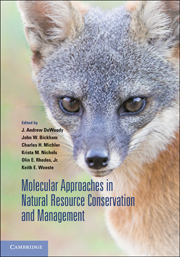Book contents
- Frontmatter
- Contents
- Contributors
- Preface
- 1 Biodiversity discovery and its importance to conservation
- 2 Gene flow, biodiversity, and genetically modified crops: Weedy rice in Thailand
- 3 A community and ecosystem genetics approach to conservation biology and management
- 4 Vertebrate sex-determining genes and their potential utility in conservation, with particular emphasis on fishes
- 5 Historical and contemporary dynamics of adaptive differentiation in European oaks
- 6 Association genetics, population genomics, and conservation: Revealing the genes underlying adaptation in natural populations of plants and animals
- 7 Hybridization in threatened and endangered animal taxa: Implications for conservation and management of biodiversity
- 8 Pollen and seed movement in disturbed tropical landscapes
- 9 Implications of landscape alteration for the conservation of genetic diversity of endangered species
- 10 Integrating evolutionary considerations into recovery planning for Pacific salmon
- 11 Using molecular methods to improve the genetic management of captive breeding programs for threatened species
- 12 Wildlife reintroductions: The conceptual development and application of theory
- 13 Evolutionary toxicology
- Index
- Plates
- References
13 - Evolutionary toxicology
Published online by Cambridge University Press: 05 July 2014
- Frontmatter
- Contents
- Contributors
- Preface
- 1 Biodiversity discovery and its importance to conservation
- 2 Gene flow, biodiversity, and genetically modified crops: Weedy rice in Thailand
- 3 A community and ecosystem genetics approach to conservation biology and management
- 4 Vertebrate sex-determining genes and their potential utility in conservation, with particular emphasis on fishes
- 5 Historical and contemporary dynamics of adaptive differentiation in European oaks
- 6 Association genetics, population genomics, and conservation: Revealing the genes underlying adaptation in natural populations of plants and animals
- 7 Hybridization in threatened and endangered animal taxa: Implications for conservation and management of biodiversity
- 8 Pollen and seed movement in disturbed tropical landscapes
- 9 Implications of landscape alteration for the conservation of genetic diversity of endangered species
- 10 Integrating evolutionary considerations into recovery planning for Pacific salmon
- 11 Using molecular methods to improve the genetic management of captive breeding programs for threatened species
- 12 Wildlife reintroductions: The conceptual development and application of theory
- 13 Evolutionary toxicology
- Index
- Plates
- References
Summary
It is clear that scientific studies that investigate the influence of environmental pollutants on evolutionary processes are applicable to all species. The discussion here, however, deals with organisms other than humans, and it recognizes, of course, that distinctions, at the molecular level, between toxic effects to humans and to other species often are not discretely distinguishable. The important distinction to be made here is that studies of the effects of environmental contaminants on human health are ultimately concerned with the health of individuals, whereas studies that deal with natural populations of wildlife or other organisms focus on the well-being of populations.
Evolutionary toxicology is the study of the effects of pollutants on the genetics of natural populations (Bickham & Smolen 1994; Bickham et al. 2000; Matson et al. 2006). The emergence of evolutionary toxicology as a new field of scientific investigation was noted in the early 1990s at the Napa Conference on Genetic and Molecular Ecotoxicology held at Yountville, California, in October 1993 (Bickham & Smolen 1994). The stated goal of this new endeavor was to identify environmental pollutants that influence evolutionary processes and to quantify the extent of their effects. The procedures and techniques of modern molecular biology to population genetics were invoked to accomplish this goal.
Evolution includes the change in inherited traits of a population from one generation to the next. Natural factors that drive genetic diversity are gene flow, mutation, natural selection, bottlenecks, and genetic drift (Belfiore & Anderson 2001; Staton et al. 2001). Mutations to genes are changes in the nucleotide sequence of an organism’s genetic material that can produce new or altered traits in individuals. These changes, in turn, can produce disease, illness, or susceptibility in numerous ways. Gene flow as a result of interactions with immigrating individuals into a population can cause a variety of effects, including increased genetic diversity, homogenization of genetic patterns across populations, and even hybridization among species. Mutations may be spontaneous or induced by exposure to genotoxins (i.e., ultraviolet and high-energy radiation or certain chemicals).
- Type
- Chapter
- Information
- Publisher: Cambridge University PressPrint publication year: 2010
References
- 8
- Cited by



